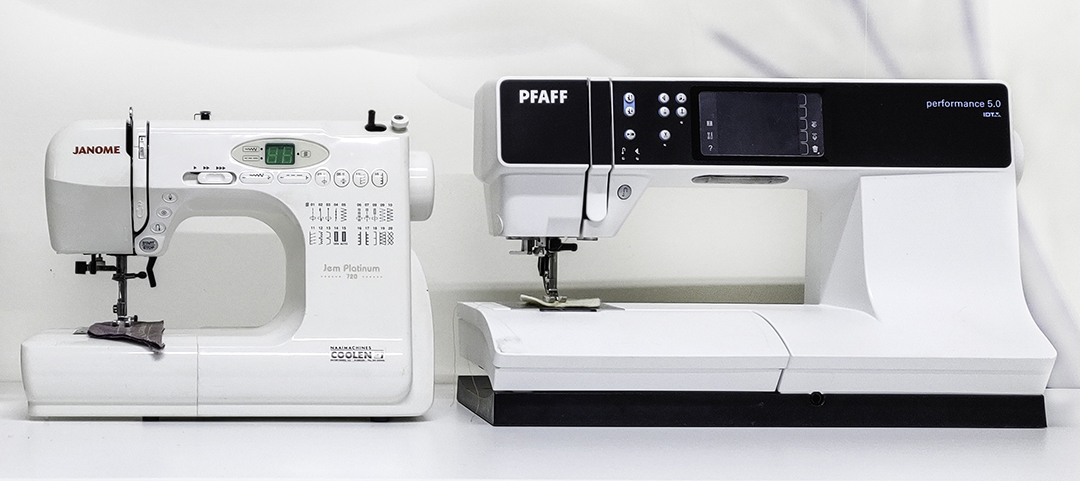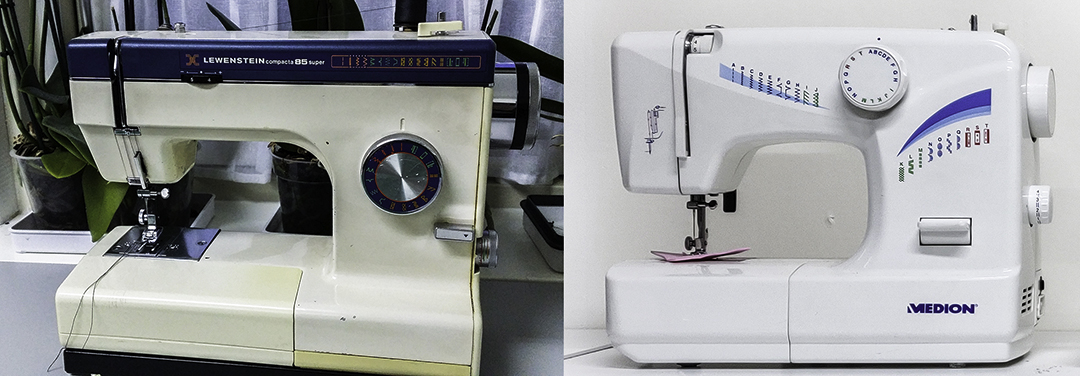
There are two types of non-industrial sewing machines, digital sewing machines and analog sewing machines. But what is the difference? The big difference is that a digital sewing machine has a computer build in to them that controls everything. From different stitches to foot pressure for example. Even automated stitches are common on a digital sewing machine. An analog sewing machine doesn’t have a build in computer. It relies on the mechanical capabilities of the machine. Most of the analog sewing machines only have few stitches. Which one is the best sewing machine, you might ask. Well that depends on what you want to do with it. You can always make it as expensive as you want it to be.
So let’s take a deeper look and see what my personal pros and cons are of both types of sewing machine’s.
Digital Sewing Machine

Most of the time an new digital sewing machine is quite expansive and they can give you some digital errors. But most problems can be fixed in a day at your local dealer. What an digital machine can stitch depends on what you pay for it. For example, I have 2 digital sewing machines that are in a different price range. Unfortunately only the most expensive one can stitch leather. A pro of an higher quality digital machine is that it has a lot of stitches. You might not even use all of the possible stitches, but if want to use the stitches they are there for you to use. Besides that, there usually is an automated button hole function and the possibility to use all kinds of sewing feet that will make your live easier. To avoid problems with you sewing machine I would advise to do regular maintenance at a dealer.
An average machine will have a new price around the €300 – €400. The machine will have most of the essential stitches. It will be able to adjust your needle position and it might have a wire threader. There are multiple helpful sewing foots available, but beware of the heavier sewing feet. They could damage your machine (like my pleating foot did to my Janome JP 720). If you want to go to hyperspace mode, a heavier machine is needed. Those machines will be more expansive, but they can sew multiple layers of jeans fabrics and even regular cow leather. Those heavier machines will have more stitches. They usually have automated button holes function too and could have integrated walking foots, you will be able to turn this feature on and off when you pleases.
Pros
- A wider selection of stitches to choose from
- Adjustable needle position
- more sewing foots available (to make life easier)
- sold in stores ( warranty)
- different price ranges
cons
- could have software problems, from problems with the tension till not working at all
- can be more expensive in maintenance
- the more you want the more you pay
Analog Sewing Machine

A Digital machine can be nice, but what if you want to start sewing. You might not even know if you like it or not and you don’t want to spend too much money on it. An analog sewing machine is also for the people that don’t care about the fancy stitches and sewing feet. They usually just want to sew a certain fabric with the basic stitches. If you want more info about a great starters machine for a low budget price, please read my other blog post “best sewing machine for low costs”.
A analog machine is perfect for a beginner, my first machine was great for basic and light fabrics. Analog machines are cheaper and the old ones are almost indestructible. In the past my mom lent me her old sewing machine when my Janome could not stitch the fabric. Old machines are beasts, in a good way! They can be bought 2nd hand or someone in your family might have one. Analog sewing machines have all the essential stitches you need to make a costume. Maybe it’s not as easy as with a fancy sewing foot (like a blind zipper foot), but that doesn’t mean it is impossible.
Most analog sewing machines have adjustable stitch lengths and withes, some might even have an adjustable needle position (it’s rare though). Because it’s all gears you won’t have software problems, but if something needs maintenance it might take a while. Because most dealer won’t have all the spare parts laying around. If you are handy you could oil and clean the machine yourself, just be careful when you do.
Pros
- could not have software problems
- are cheaper
- maintenance is cheaper
- Old machines are powerful
cons
- A smaller selection of stitches to choose from
- Most don’t have an adjustable needle position
- less sewing foots available
- maintenance could take longer
Conclusion
If you don’t care about extra options an old analog sewing machine is great. If you have an old analog sewing machine and consider getting an digital machine, don’t throw your old analog machine away! It might come in handy if you need some heavy work done, but beware newer analog machines are not as strong as the old ones.
Digital machines are great they make your sewing life easier. They variety of different sewing feet or fancy/handy stitches are limitless. Even though you might not use all those stitches they are helpful. That one stich you never used before could save your project. Just keep in mind that more features means a higher prices. So always consider, is this feature worth the increase in price.
Sewing is a big part of my life so that’s why I’m really happy with my latest digital machine. That doesn’t mean I don’t use my old machines. I usually use my old machines if my Pfaff is in maintenance, if I’m to lazy to switch yarn colors and have a 2-tone project or if I learn friends to sew. So remember when you buy or upgrade a sewing machine, sum up the features you really need and then look at the upgrades for your machine that are worth the price.



